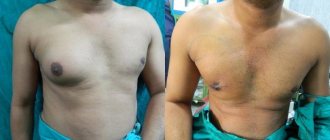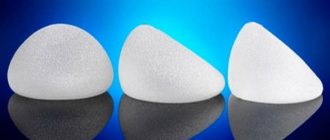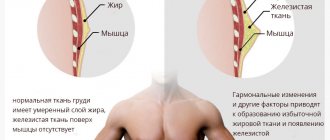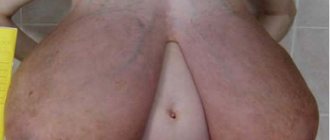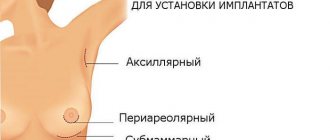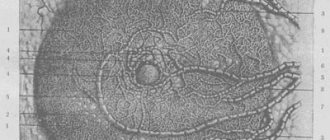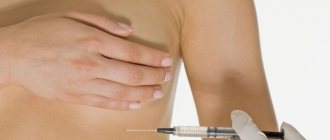Breasts or, in medical terminology, mammary glands are part of the human reproductive system, designed for raising offspring. Their main task is to produce milk.
Solve your life problems. Change your destiny!
Ask the Universe for whatever you want: ⭐ Love ⭐ Money ⭐ Career ⭐ and more
To learn more
Representatives of both sexes are endowed with this gland by nature. However, there is an important difference.
At a certain age, under the influence of hormones, girls begin their menstrual cycle and their breasts develop, increasing in size. Having reached the peak of their development, they perform the function assigned by nature.
But for men everything is different. Their breasts are indistinguishable from those of a woman in childhood, and, as a rule, they do not develop or enlarge with age. However, in medical practice, we sometimes encounter swelling of the mammary glands in teenage boys.
Causes of swelling
Men are also affected by hormonal surges, causing their breasts to become larger. This deviation is possible both in a one-year-old baby and in older children.
A bust in men appears for physiological or pathological reasons.
Physiological reasons have one reason - unstable levels of hormones in the body.
The hormonal balance in newborns is initially in an unstable state. This is due to the fact that after separation from the mother, female hormones are still present in the fetus’s body.
Adolescents also experience an imbalance of substances, which is caused by increased production of female and male hormones. After puberty, male breasts acquire a natural size. Both are normal.
Pathological causes include:
- Obesity. Fat helps stimulate the growth of estrogen in the body, which leads to breast swelling.
- Testicular cancer, kidney, liver, adrenal and stomach diseases.
- Breast injuries.
- Irregular eating with prolonged fasting and severe overeating. Especially during rehabilitation after overwork.
- Insufficient testosterone production or increased estrogen production.
- The use of drugs and medications to increase muscle mass (steroids, etc.).
- Poor quality linen.
- Low level of children's activity.
- Poor diet with excessive amounts of fats and carbohydrates.
- Metabolic disorders.
- Other diseases of the endocrine system.
You can independently prevent the appearance of breasts in a boy, as well as diagnose already formed breasts.
Chest pain in children
Whooping cough
Gastritis
Ulcer
16579 March 11
IMPORTANT!
The information in this section cannot be used for self-diagnosis and self-treatment.
In case of pain or other exacerbation of the disease, diagnostic tests should be prescribed only by the attending physician. To make a diagnosis and properly prescribe treatment, you should contact your doctor. Chest pain in children: causes of occurrence, what diseases it occurs with, diagnosis and treatment methods.
Definition
The physiological significance of any pain is associated with the protection of the body from destruction, i.e. with a warning system about real or potential danger of damage. The pain signal ensures timely mobilization of the body's defenses.
When it comes to a child, his complaints of pain must be treated with special care, since children cannot always accurately characterize its specifics and even localization.
Chest pain can be caused by both intense physical activity and serious diseases of the organs located in the chest.
The sensation of pain significantly limits the activity of a small child, which can affect his psychomotor development. At an older age, pain can cause problems with the child’s socialization and adaptation in the children’s group.
Types of chest pain in children
There are acute and chronic pain, and depending on its nature - stabbing, pressing, squeezing, aching.
Possible causes of chest pain in children
Children often complain of chest pain after intense physical activity. If such complaints are isolated, then the appearance of pain can be explained by overstrain of the ligamentous apparatus - in this case, after a short rest, the pain disappears on its own and is not considered pathological.
Chest pain may result from an injury (such as a broken rib).
Pain that occurs after eating should alert parents, since it can serve as a symptom of a gastrointestinal tract disease, for example, gastroesophageal reflux, gastritis or gastric ulcer, either alone or combined with such manifestations as belching, sour taste in the mouth, heaviness in the abdomen, difficulty defecating.
Various respiratory diseases (for example, whooping cough) associated with a debilitating cough often cause chest pain in children. This is due to excessive tension in the intercostal muscles. Chest pain with pneumonia may be associated with the spread of the inflammatory process to the pleura. In this case, the child usually takes a forced position, sparing the affected side, a superficial cough and a rise in body temperature are observed.
Some diseases (lung abscess, tuberculosis) are fraught with the development of pneumothorax (accumulation of air in the pleural cavity, leading to collapse of lung tissue and compression of the blood vessels of the mediastinum).
Chest pain that occurs or worsens during movement is often a symptom of damage to the spinal nerve roots due to poor posture, scoliosis, or spina bifida.
In adolescence, chest pain is associated with intensive growth of the musculoskeletal system and delayed development of the cardiovascular and nervous systems. Such pain may be accompanied by rapid heartbeat, dizziness and other unpleasant subjective sensations in the chest.
Prolonged chest pain can be caused by infectious diseases, such as herpes zoster caused by type IV herpes. The disease is characterized by the appearance of small, profuse rashes along the affected nerve, often in the chest area. This rash is very itchy and causes significant discomfort.
Among the heart diseases that cause chest pain in children, myocarditis should be highlighted. It often develops against the background of an acute respiratory viral infection or intestinal infection (caused, for example, by the Coxsackie virus) or within two weeks after it. Young children with an unfavorable perinatal history are most susceptible to developing myocarditis. An increase in body temperature is often the first symptom of the development of myocarditis. Subsequently, shortness of breath and pain in the chest area appear, the child becomes restless, whiny, and reflex vomiting may occur.
Myocardial infarction (impaired oxygen delivery to the myocardium, leading to necrosis of the heart muscle) is an extremely rare disease in children.
A heart attack can occur as a result of atherosclerosis in familial forms of hyperlipidemia, anomalous origin of the left coronary artery, Kawasaki disease, vasculitis of the coronary arteries, and infective endocarditis. The disease is characterized by burning pain in the chest, as well as difficulty breathing, sweating, shortness of breath, and decreased blood pressure. In isolated cases, abdominal pain, vomiting, and diarrhea are noted.
If all somatic (physical) pathologies are excluded and chest pain persists, it is necessary to pay attention to the child’s mental state. Children and adolescents with anxiety and depressive disorders often complain of chest pain, palpitations and difficulty breathing.
Which doctors should I contact if I have chest pain in children?
If a child experiences chest pain, you should contact him. After an examination and medical history, the doctor will prescribe a set of laboratory and instrumental studies and consultations with specialists.
An examination by a pediatric cardiologist, orthopedist, rheumatologist, neurologist, gastroenterologist, or psychiatrist may be required.
Diagnosis and examinations for chest pain in children
In most cases, making a diagnosis requires a set of laboratory and instrumental studies, a list of which is compiled by the doctor, focusing on the patient’s condition and existing symptoms.
- Clinical blood test: general analysis with platelet count, leukoformula, ESR (with microscopy of a blood smear in the presence of pathological changes).
Diagnostics
Self-diagnosis is an external examination. The boy should stand directly in front of the person examining him. Outwardly, it can be seen that the breasts can increase by about ten to fifteen centimeters. The breasts may swell and gain significant weight.
One or both glands are affected. The nipple can also be enlarged to a diameter of approximately three to four centimeters.
The breasts may be tender to the touch, and your teen may feel heaviness, burning, and throbbing from the inside. A lump may also be felt in the chest. The glands may become more sensitive.
Sometimes colostrum is released from one nipple. It is a white liquid similar to milk.
At the advanced stage there are:
- Severe pain on palpation.
- Bloody discharge from the nipple or its shape.
- The axillary lymph nodes are significantly enlarged and cause discomfort.
- Changes in the condition of the skin on the chest (appearance of rashes, ulcers).
Call your doctor if your teen has swollen breasts. During a medical examination, the doctor discovers that the breast size does not correspond to the boy’s age.
The doctor is also required to conduct an examination, including palpation of the breasts and testicles. To find out about the genetic characteristics of the body, you must undergo an interview.
Hormone therapy is prescribed or a decision is made about surgery.
Treatment, with the exception of surgery, consists of observing the rules of personal hygiene. This is necessary to prevent infection from entering the body.
Therapy consists of:
- Uses hormones to balance their levels in the body. Relies on a complex of vitamins and sedatives.
- Schedule a date for physical therapy.
- Use of folk remedies.
- Diet (if the problem is obesity).
- Surgical intervention is the removal of the glands and fat layer, followed by rehabilitation and drawing up a list of recommendations from the surgeon. It is performed if a breast tumor is suspected.
In the absence of pathologies, the operation is performed for cosmetic purposes if treatment with hormonal drugs is ineffective.
Every person is endowed with a so-called biological clock. Its job is to regulate the growth, development and functioning of a person. The body is at different stages of life.
Survey
There is currently debate about how gynecomastia should be diagnosed and assessed. Three mammographic patterns of gynecomastia are observed: glandular, dendritic and nodular. On ultrasound, gynecomastia is considered as a diffuse or focal process.
Differentiation from breast cancer in men
Suspicion of breast cancer in men should always be raised when diagnosing gynecomastia, especially among the adult population.
Approaches to diagnosis and treatment are based on the fact that breast cancer in men is similar to breast cancer in postmenopausal women. Although the disease was rare in 2005, about 1,700 new cases of breast cancer in men were diagnosed in the United States, with about 460 deaths. Male breast cancer has a unimodal age range, with a peak age of 71 years, whereas in women it is bimodal, with peaks at ages 52 and 71 years.
Breast cancer in men is thought to be associated with a relative excess of estrogen or lack of androgens. Conditions with an increased risk of breast cancer include:
- testicular abnormalities such as undescended testicle and orchitis;
- family history of female breast cancer;
- previous irradiation of the chest wall;
- Klinefelter's syndrome. Klinefelter syndrome carries the highest risk of developing breast cancer, increasing the risk in men by 16 times. Associated with this syndrome are atrophic testicles, gynecomastia, elevated levels of gonadotropins (FSH and LSH), low plasma testosterone levels, and a high estrogen to testosterone ratio. Discordant associations with breast cancer include: alcohol consumption, liver disease, obesity, electromagnetic fields, and diet.
It is believed that approximately 5–10% of breast cancer cases have a genetic predisposition. The genetically most strongly associated breast cancer syndrome in men is associated with the BRCA2 gene, which is inherited in an autosomal dominant manner and occurs in 4–16% of men with breast cancer. When the gene is present, cancer tends to appear at a younger age and predicts worse survival.
Typically, male breast cancer presents as a firm, unilateral breast nodule eccentric to the subareolar tissue with occasional nipple discharge. Bilateral disease is rare in <1%. The average delay in diagnosis is 6–10 months. This is often due to a low index of suspicion on the part of doctors and patients. More than 40% of male breast cancer is present at stages III and IV.
Differential diagnosis must be made between gynecomastia, breast abscess, breast metastases and other soft tissue malignancies such as sarcoma.
Ultrasound is useful for diagnosis. All solid and complex cystic masses require biopsy. If inadequate tissue is obtained, a core biopsy or open biopsy will be required.
At what age can the disease occur?
Each of these stages, be it childhood, adolescence or old age, is not easy for the body. The body is constantly being rebuilt, the level of hormones changes, and the person “adapts” to the new stage.
A newborn may be born with swollen breasts due to still having the mother's hormones, but the baby gradually adjusts to life outside the womb. This affects hormone levels.
Adolescence is especially difficult for a person.
It consists of several stages:
Pre-pubertal period (from eight to ten years).
- Puberty (eleven to sixteen years).
- Adulthood (from seventeen to twenty-one years).
- Certain changes occur, which are expressed in a surge of hormones. They affect hair growth, skin, maturation, mood and figure.
This is due to the fact that during the transitional age from childhood to adulthood, the body is weakened, unstable and susceptible to various diseases. Hormones are responsible for all the changes that occur during puberty.
The guy feels that the glands are starting to swell and hurt. In this condition, they should be handled with care during the examination.
This process can occur between the ages of 11 and 18 years.
How often does it occur?
In adulthood, a situation may arise when a young man’s breasts become visually larger, but this may be due to excess weight or a jump in the level of estrogen (female hormone).
Swollen breasts occur in 60% of the male population during puberty. In some cases, boys are diagnosed with swollen nipples, while the gland remains normal.
The pathology can persist for a long time. Usually, swollen breasts in a newborn baby “go away” after a few weeks or months, sometimes after a year. In a teenager or young adult, the glands return to normal after two years of growth.
Treatment
Conservative therapy
The tactics of conservative treatment are determined by the nature of the pathology. When nipple retraction is caused by individual anatomical features, women are recommended to use vacuum attachments. During the feeding period, special pads can be used.
The main method of treatment for breast cancer is surgery; conservative techniques are often indicated in the preoperative and postoperative period. For metastases to the lymph nodes, radiation therapy is performed. At a high risk of hematogenous and lymphogenous metastasis, cytostatics are used. The progression of hormone-dependent cancer is slowed by prescribing drugs that reduce the effect of hormones on gland cells.
For fibrocystic dysplasia, tamoxifen and analogues are used, and oral contraceptives are recommended to normalize the menstrual cycle. The treatment regimen for tuberculosis includes anti-tuberculosis therapy, ultraviolet irradiation, inductothermy, magnetic therapy, UHF, and drug electrophoresis.
Surgery
Patients with indentation not associated with other diseases undergo plastic surgery to correct inverted nipples. If a woman plans to have children in the future, a microsurgical operation is performed, during which the connective tissue cords are cut and the milk ducts are preserved. If pregnancy is not planned, it is possible to dissect the connective tissue along with the milk ducts.
Areas of fat necrosis, intraductal papillomas and tuberculous foci are excised by sectoral resection. For cancerous tumors, the following operations on the mammary gland are performed:
- radical resection;
- oncoplastic resection;
- subcutaneous mastectomy;
- radical mastectomy;
- mastectomy with radiation;
- mastectomy with prosthetics;
- mastectomy with reconstruction using own tissues.
